What is an SQDCME Board?
An SQDCME Balanced Scorecard is a performance management tool used to track and improve performance across six critical areas: Safety, Quality, Delivery, Cost, Morale, and Environment. It helps organisations monitor key metrics, identify inefficiencies, and promote continuous improvement in operations.
- Safety: Promoting a safe and compliant work environment by proactively identifying hazards, mitigating risks, and preventing workplace incidents.
- Quality: Ensuring consistent excellence in products and processes through rigorous quality standards, continuous improvement, and defect prevention.
- Delivery: Achieving dependable and timely order fulfillment by optimising workflow efficiency and minimising delays throughout the supply chain.
- Cost: Enhancing financial performance by maximising resource utilisation, minimising operational waste, and improving cost-efficiency.
- Morale: Fostering a collaborative and supportive workplace culture that prioritises employee engagement, well-being, and team performance.
- Environment: Supporting sustainability goals by reducing environmental impact, managing waste responsibly, and complying with environmental regulations.
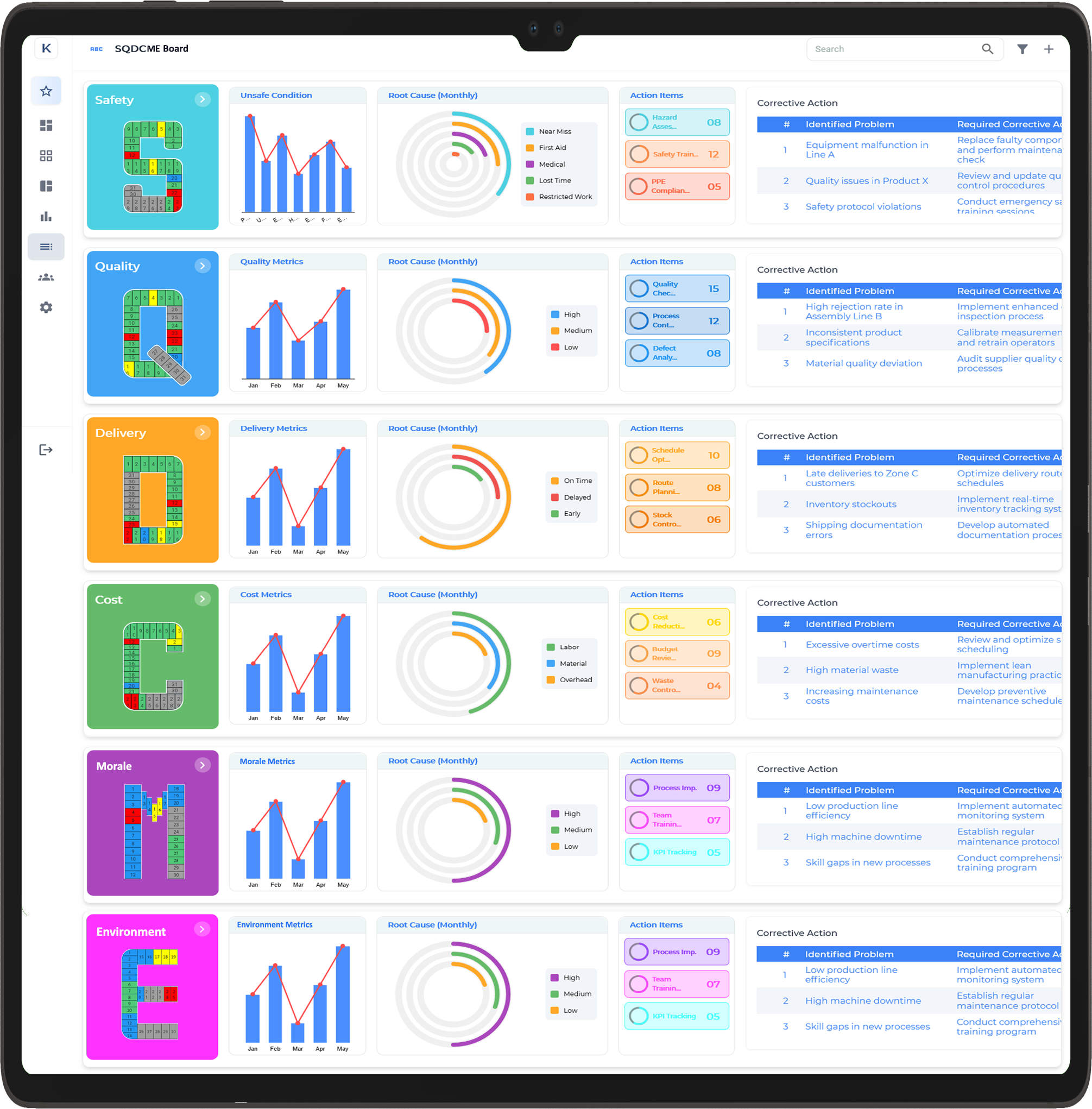
Safety
The Balanced Scorecard plays a vital role in strengthening workplace safety by systematically tracking safety-related events. Through the monitoring of reported accidents and near-miss incidents, it delivers actionable insights into the effectiveness of existing safety measures and highlights areas for proactive improvement.
- Total Reported Workplace Accidents
- Documented High-Potential Near-Miss Incidents
- Safety Incidents with Root Cause Analysis Completed
- Conducted Safety Briefings and Training Programs
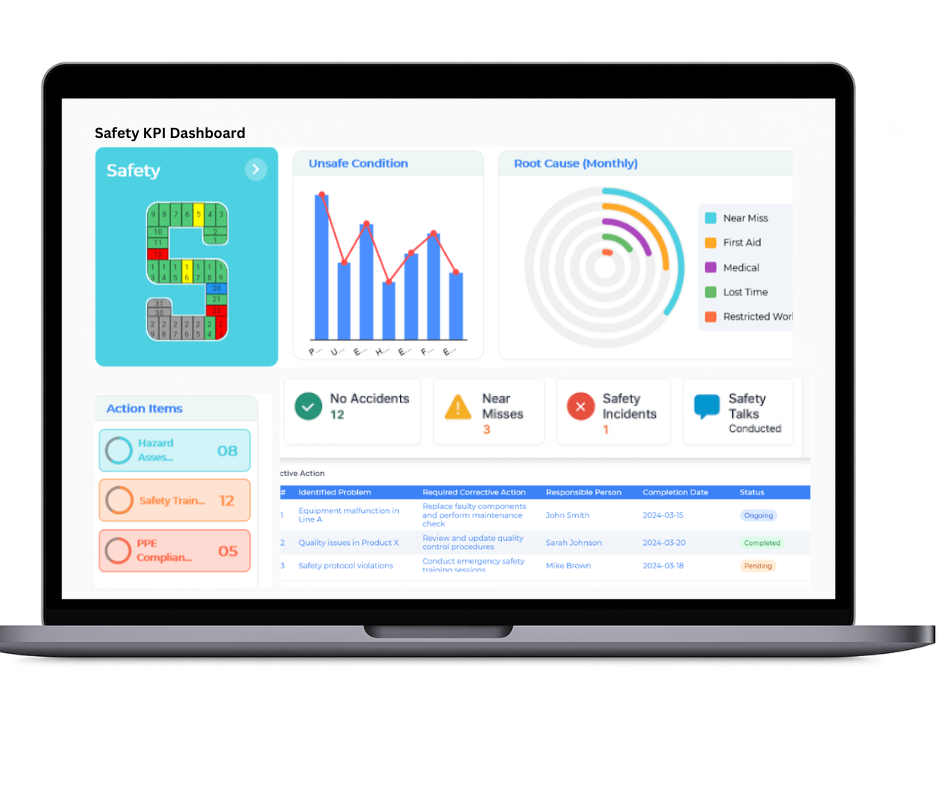
Quality
The Balanced Scorecard’s quality metrics offer a holistic evaluation of both product and process integrity. By monitoring defects, inspection failures, rework rates, and non-conformance reports—along with supplier and customer feedback—organisations can reinforce their quality management systems and foster a culture of continuous improvement.
- Identified Product Defects
- Failed Quality Inspections and Functional Tests
- Logged Rework and Corrective Actions
- Issued Non-Conformance Reports (NCRs)
- Detected Quality Issues in Supplier Materials
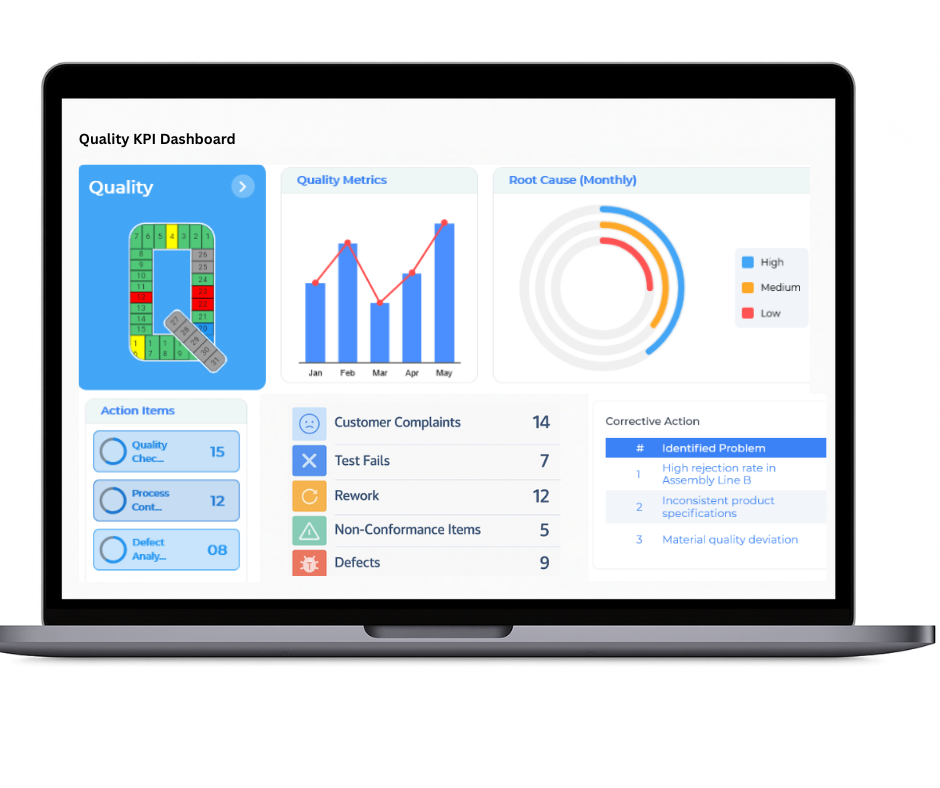
Delivery
The Balanced Scorecard provides a comprehensive assessment of the entire delivery process, ensuring consistent On Time In Full (OTIF) performance from supplier dispatch to final customer delivery. It evaluates logistics efficiency, order fulfillment accuracy, and inventory flow, offering critical insights that help optimise supply chain operations and support strategic decision-making.
- Tracked Late Deliveries and Root Causes
- Measured On Time In Full (OTIF) Delivery Performance
- Accuracy of Order Fulfillment and Dispatch
- Efficiency in Warehouse Operations and Inventory Turnover

Cost
Strategic cost management is essential for maintaining financial health and driving long-term profitability. The Balanced Scorecard offers a structured approach to monitoring financial performance by tracking key cost-related metrics. It empowers organisations to uncover cost-saving opportunities, ensure budget discipline, and make informed decisions that enhance operational and financial efficiency.
- Implementation of Cost Reduction Strategies
- Comprehensive Expense Tracking and Oversight
- Improvements in Operational Cost Efficiency
- Monitoring and Enforcement of Budget Compliance
- Optimised Resource Allocation and Utilisation
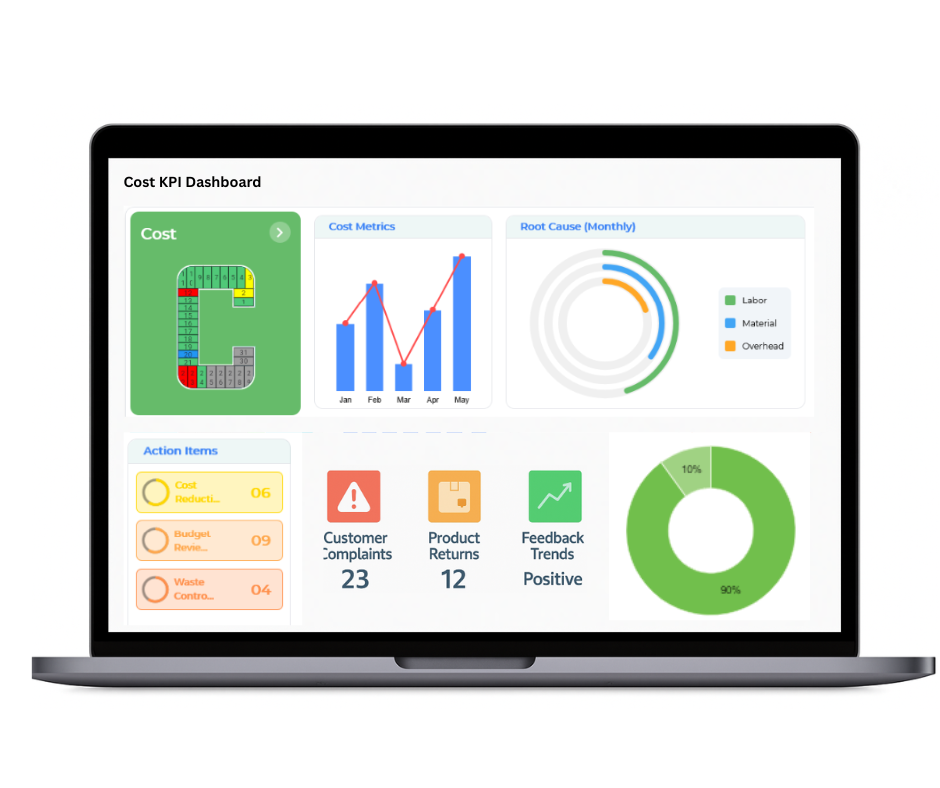
Morale
The Balanced Scorecard plays a vital role in strengthening employee morale by monitoring key aspects of the workforce experience—including job satisfaction, collaboration, and engagement. By consistently evaluating these indicators, organisations can cultivate a supportive work culture, boost productivity, and drive sustained team performance.
- Employee Engagement and Satisfaction Ratings
- Effectiveness of Team Collaboration and Communication
- Retention Rates and Workforce Turnover Analysis
- Initiatives Supporting Workplace Health and Well-Being
- Access to Training, Learning, and Development Programs
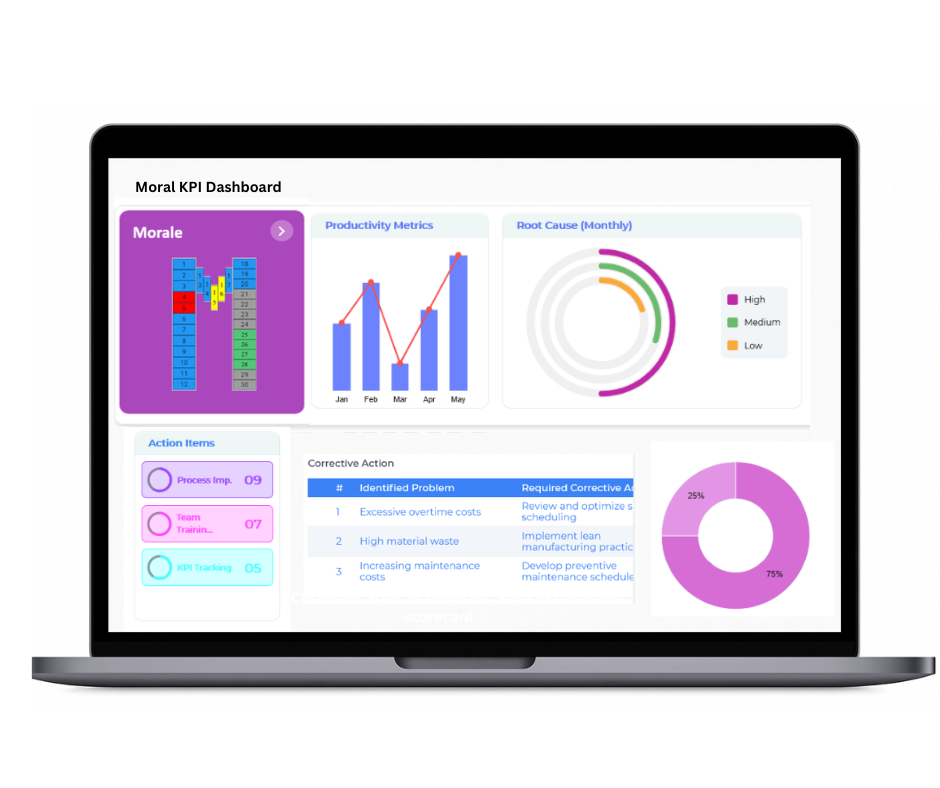
Environment
The Balanced Scorecard supports proactive environmental stewardship by tracking key sustainability metrics and ecological impacts. By integrating environmental performance into daily operations, organisations can promote regulatory compliance, reduce their ecological footprint, and drive long-term sustainability initiatives. This focus not only protects the environment but also enhances operational efficiency and corporate responsibility.
- Energy and Water Consumption Monitoring
- Waste Reduction and Recycling Initiatives
- Carbon Emissions Tracking and Reporting
- Compliance with Environmental Regulations and Standards
- Implementation of Sustainable Resource Management Practices
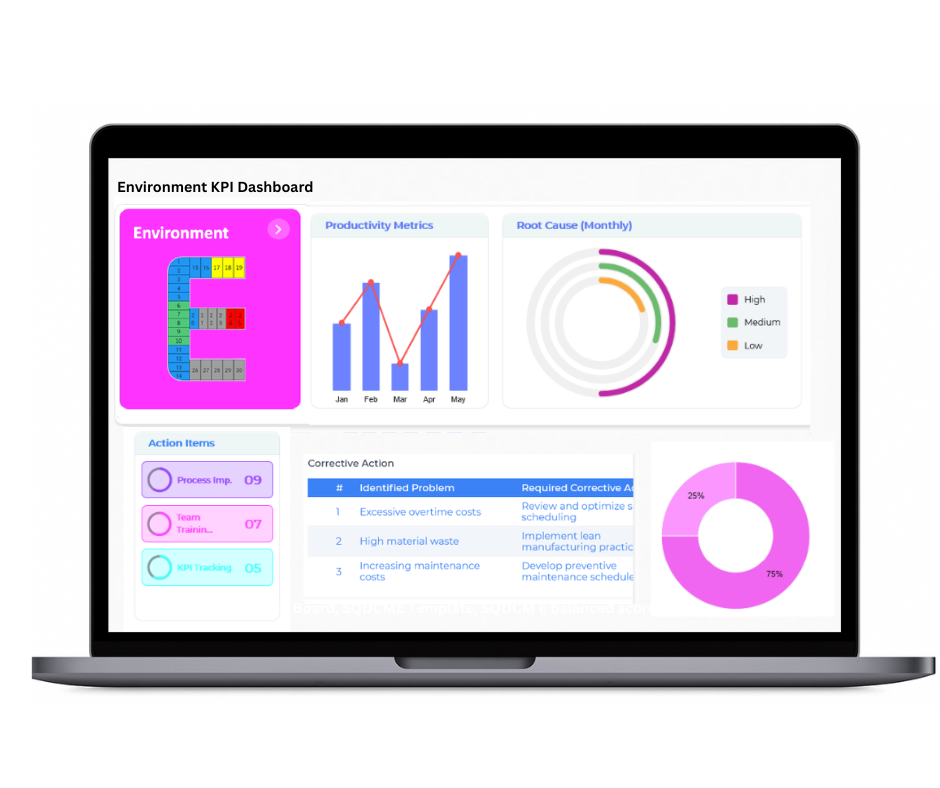
SQDCME Board for Shift Management
- Integrated Real-Time Performance Monitoring: Continuously tracks key operational metrics across Safety, Quality, Delivery, Cost, Morale, and Environmental impact to ensure consistent performance and strategic alignment.
- Advanced Safety Oversight: Monitors workplace incidents, near-misses, and audit findings to reinforce a strong safety culture and reduce risk across all operational levels.
- Quality Control at Every Stage: Evaluates defect rates, rework trends, and compliance with quality standards to promote excellence in both products and processes.
- Optimised Delivery and Throughput: Tracks On Time In Full (OTIF) performance, identifies production bottlenecks, and enhances scheduling accuracy for timely customer fulfillment.
- Cost Efficiency and Resource Utilisation: Assesses cost drivers, waste reduction efforts, and resource allocation to improve profitability and budget adherence.
- Morale and Workforce Engagement: Measures employee satisfaction, collaboration, attendance, and training progress to build a positive, high-performance culture.
- Environmental Sustainability Monitoring: Tracks energy usage, waste management, emissions, and compliance with environmental standards to support sustainable operations and corporate responsibility.
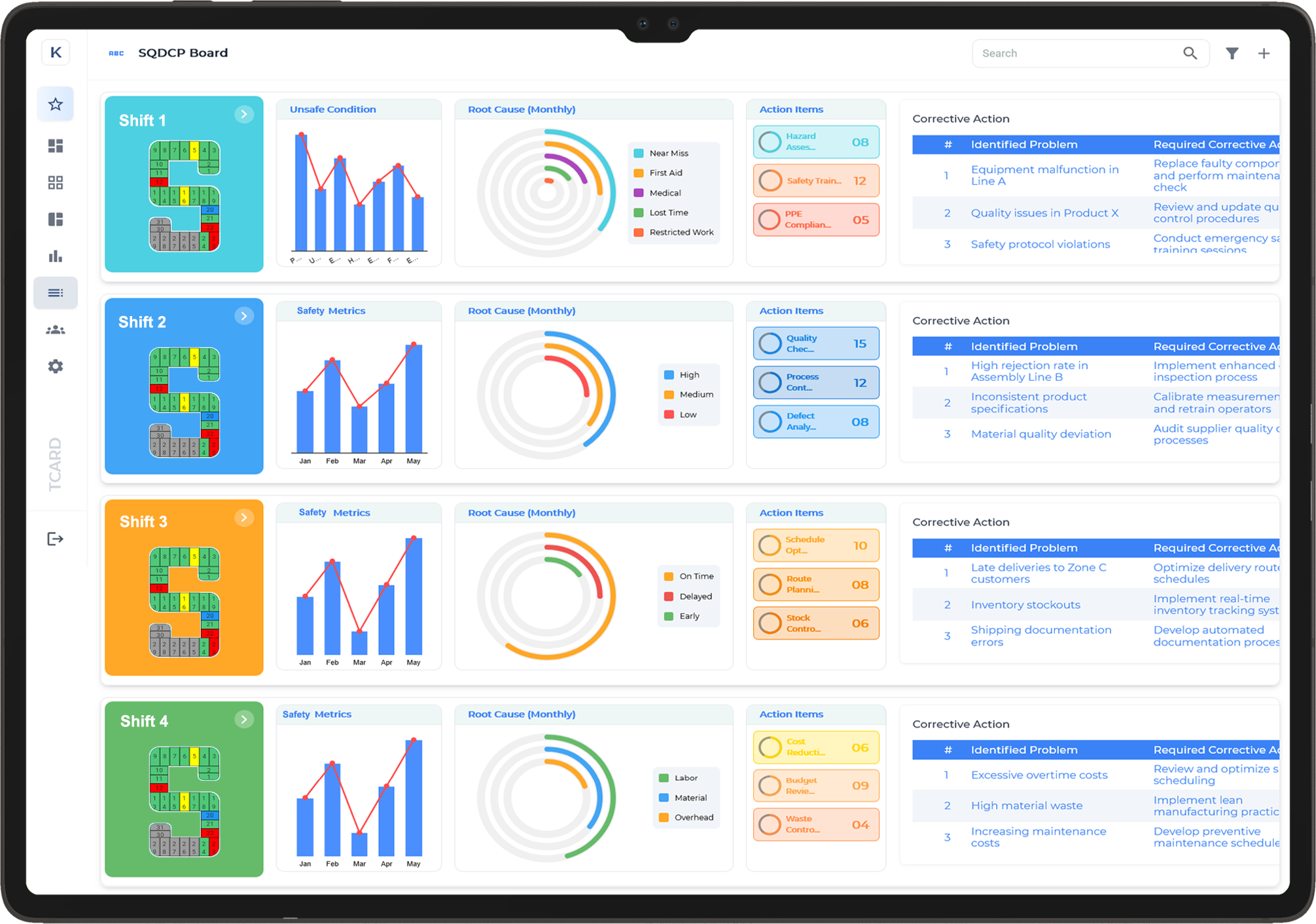
What Does SQDCME Stand For? An Introduction to Key Performance Metrics
SQDCME is a powerful framework used by organisations to track and improve their key performance metrics. It stands for Safety, Quality, Delivery, Cost, Maintenance, and Environment. Each of these categories is essential for measuring operational efficiency and ensuring continuous improvement across various industries.
Safety
The 'S' in SQDCME focuses on ensuring a safe working environment. Organisations monitor safety incidents, risks, and preventive measures to protect employees and reduce accidents. Safety is a top priority in any operation, as it directly affects employee well-being and productivity.
Quality
The 'Q' represents the quality of products or services delivered. It measures how well the output meets customer expectations and compliance standards. Consistently meeting high-quality standards is vital for customer satisfaction and long-term business success.
Delivery
Delivery, represented by the 'D', tracks the timely and accurate delivery of products or services. Meeting deadlines and fulfilling orders on time is crucial to maintaining customer trust and satisfaction.
Cost
The 'C' in SQDCME refers to managing costs efficiently. By keeping expenses under control while maintaining high standards of quality and safety, organisations can maximise profitability and competitiveness.
Maintenance
'M' stands for maintenance, which involves ensuring that equipment and systems are well-maintained and operate smoothly. Proper maintenance reduces downtime, prevents costly repairs, and ensures operational reliability.
Environment
Lastly, the 'E' focuses on the environmental impact of operations. Organisations are increasingly aware of their environmental footprint, and the 'E' ensures that businesses are complying with regulations and implementing sustainable practices.
By monitoring these key metrics, businesses can drive performance improvements and create a balanced, efficient operation.
How the SQDCME Board Drives Operational Excellence in Your Organisation
The SQDCME board is an essential tool that helps organisations achieve operational excellence by tracking key performance metrics across six critical areas: Safety, Quality, Delivery, Cost, Maintenance, and Environment. This visual management tool provides a clear and concise overview of performance, enabling teams to make data-driven decisions that improve efficiency, reduce waste, and drive continuous improvement.
Safety
The 'S' in SQDCME focuses on creating a safe work environment. By tracking safety incidents and hazards, organisations can identify risks and implement preventive measures to protect employees. A safe workplace is essential for maintaining productivity and employee morale.
Quality
The 'Q' measures the quality of products or services. The SQDCME board helps teams track defects, rework, and customer complaints, ensuring that high standards are maintained. Consistently delivering quality output builds customer trust and enhances business reputation.
Delivery
Delivery, represented by the 'D', tracks the timeliness and accuracy of product or service delivery. The SQDCME board helps teams monitor progress towards meeting deadlines, ensuring that customers receive their orders on time and as expected, which is crucial for customer satisfaction.
Cost
The 'C' refers to cost management. The board helps teams track operational costs, identify inefficiencies, and ensure that resources are being used effectively. By controlling costs, organisations can improve profitability and remain competitive in the market.
Maintenance
'M' focuses on maintaining equipment and systems to avoid breakdowns. Regular monitoring of maintenance metrics ensures that machinery runs smoothly, reducing downtime and preventing expensive repairs.
Environment
Finally, the 'E' ensures that organisations comply with environmental regulations and reduce their environmental impact. The SQDCME board tracks energy consumption, waste management, and sustainability efforts, helping businesses operate responsibly.
Incorporating the SQDCME board into daily operations fosters a culture of continuous improvement, driving overall business performance and operational excellence.
Safety (S) First: Why It’s Essential for Maintaining a Safe Working Environment
Safety (S) is the cornerstone of any successful organisation, as it ensures the well-being of employees, reduces the risk of accidents, and promotes a positive workplace culture. Maintaining a safe working environment is not just about following regulations; it’s about creating an atmosphere where employees feel valued and secure. The focus on safety within a company’s operational framework can lead to increased productivity, reduced absenteeism, and a higher level of employee satisfaction.
Reducing Workplace Incidents
By tracking safety metrics such as accidents, near-misses, and hazards on a regular basis, organisations can identify potential risks and implement preventive measures. The use of safety protocols and training ensures that employees understand how to protect themselves and their colleagues from harm. This proactive approach significantly reduces the likelihood of accidents and injuries in the workplace.
Improving Employee Morale
A safe work environment builds trust and boosts employee morale. When workers feel that their safety is a priority, they are more likely to be engaged and committed to their roles. High morale often translates into better performance and lower turnover, contributing to long-term success for the organisation.
Compliance and Legal Responsibility
In addition to protecting workers, safety measures help businesses comply with legal requirements and avoid costly fines. Regular safety audits, proper equipment maintenance, and training ensure that the organisation meets regulatory standards, safeguarding both employees and the business itself.
Ultimately, prioritising safety creates a stable, efficient, and productive workplace, making it an essential aspect of any organisation’s success.
Quality Control (Q) in SQDCME: Ensuring Consistency and Customer Satisfaction
Quality control (Q) plays a pivotal role in ensuring the consistency and reliability of products and services. In the SQDCME framework, quality control is a key metric that helps organisations maintain high standards and meet customer expectations. By focusing on quality, companies can enhance their reputation, build customer loyalty, and achieve long-term success in the marketplace.
Maintaining Consistency
Consistency in product or service quality is vital for any business. Quality control ensures that every product meets the same high standards, regardless of production scale. Regular inspections, testing, and monitoring help identify any deviations from set standards and allow corrective actions to be taken promptly. This ensures that customers receive a reliable and consistent experience every time they interact with the business.
Meeting Customer Expectations
Customer satisfaction is directly linked to the quality of the product or service. By monitoring quality through the SQDCME board, businesses can identify areas for improvement and prevent defects or errors. A robust quality control system helps ensure that the product or service meets or exceeds customer expectations, leading to higher satisfaction and repeat business.
Reducing Costs and Waste
Effective quality control also helps reduce costs associated with returns, rework, or waste. By identifying issues early in the production process, businesses can prevent costly mistakes and improve operational efficiency. This contributes to overall cost savings, while maintaining the integrity and quality of the product.
Ultimately, quality control within the SQDCME framework is essential for driving customer satisfaction, ensuring consistency, and fostering business growth.
Delivery (D): How SQDCME Boards Improve Timeliness and Customer Expectations
In the competitive business world, meeting deadlines and ensuring timely delivery is essential for maintaining customer satisfaction. Delivery (D) within the SQDCME framework focuses on optimising and tracking the timeliness of product or service delivery. By integrating this key metric into your operations, businesses can better manage customer expectations, reduce delays, and enhance overall performance.
Ensuring Timely Deliveries
Timeliness is critical in meeting customer expectations. SQDCME boards help organisations track delivery performance by monitoring real-time data on production, shipping, and order fulfilment. This allows teams to identify any delays in the process and take immediate corrective action. By ensuring products and services are delivered on time, businesses can enhance their reliability and build strong customer relationships.
Meeting Customer Expectations
Customers expect products and services to be delivered within the promised timeframe. Consistently meeting these expectations fosters trust and satisfaction. By tracking delivery performance through the SQDCME board, businesses can ensure they meet deadlines, which in turn boosts customer loyalty and reputation. Reliable delivery can be a key differentiator in competitive markets.
Improving Operational Efficiency
Effective delivery management helps streamline operations and reduce bottlenecks. With SQDCME boards, businesses can identify areas where delays occur and implement improvements, whether that be in the supply chain, production process, or distribution. This leads to more efficient operations, cost savings, and enhanced customer experience.

Cost Management (C): Tracking and Minimising Operational Costs with SQDCME
Cost management is a critical component of any successful business strategy. Within the SQDCME framework, the 'C' represents the focus on tracking and minimising operational costs. By monitoring costs effectively, businesses can ensure they operate efficiently, maximise profitability, and maintain competitiveness in their respective markets.
Tracking Operational Costs
To manage costs effectively, it’s essential to have a clear understanding of where and how resources are being used. SQDCME boards help track operational costs in real time, providing teams with visibility on areas where expenses may be higher than necessary. This data allows businesses to pinpoint inefficiencies and take corrective actions promptly.
Minimising Waste and Reducing Expenses
One of the key goals of cost management is to reduce waste. By using SQDCME boards, organisations can identify where resources such as time, materials, and labour are being underutilised or wasted. This insight helps businesses streamline processes, eliminate unnecessary steps, and optimise resource allocation, ultimately lowering operational costs.
Improving Profit Margins
Effective cost management doesn’t just focus on cutting expenses—it also involves improving operational efficiency. By reducing unnecessary costs and improving resource allocation, businesses can increase their profit margins. With SQDCME boards, teams can stay focused on both cost-cutting and value-generating activities, ensuring a balanced approach to financial health.
Maintenance (M): Maximising Equipment Uptime for Greater Efficiency
In any business, ensuring that equipment runs smoothly and efficiently is crucial for maintaining high productivity levels. The 'M' in SQDCME stands for Maintenance, emphasising the importance of proactive equipment management. By focusing on maintenance, organisations can maximise equipment uptime, reduce breakdowns, and enhance overall operational efficiency.
Preventative Maintenance
One of the key strategies for maximising equipment uptime is preventative maintenance. By conducting regular checks and servicing, businesses can detect potential issues before they become major problems. This proactive approach helps avoid unexpected downtime, reduces repair costs, and ensures that equipment operates at optimal performance.
Minimising Unplanned Downtime
Unplanned equipment downtime can be costly, both in terms of lost production and the expenses associated with emergency repairs. SQDCME boards help businesses track maintenance schedules and flag any potential issues early, reducing the risk of unplanned downtime. By staying on top of maintenance needs, companies can maintain a consistent flow of operations and meet customer demands more reliably.
Boosting Efficiency and Reliability
Well-maintained equipment not only operates more reliably but also performs more efficiently. Regular maintenance helps to extend the lifespan of machinery, enhance energy efficiency, and improve the overall quality of output. This leads to reduced operational costs and ensures that resources are used effectively, contributing to greater business success.
Environment (E): Incorporating Environmental Goals into Your Performance Metrics
The 'E' in SQDCME represents Environment, highlighting the growing importance of integrating environmental considerations into business performance metrics. As organisations strive for sustainability, it’s essential to track environmental impact alongside traditional operational factors like safety, quality, delivery, cost, and maintenance. By including environmental goals, businesses not only contribute to global sustainability but also enhance their brand reputation and long-term viability.
Reducing Environmental Impact
Tracking environmental performance can help businesses identify areas where they can reduce waste, lower energy consumption, and minimise carbon emissions. Setting clear environmental targets within the SQDCME framework ensures that these efforts are actively monitored and addressed. Whether it’s reducing packaging waste or improving energy efficiency, businesses can take measurable steps to minimise their ecological footprint.
Regulatory Compliance
Incorporating environmental metrics also helps businesses stay compliant with local and international regulations. With increasing environmental laws and regulations, organisations that prioritise sustainability are better positioned to avoid penalties and enhance their operational practices. The environment section of the SQDCME board can track compliance progress and ensure businesses meet their environmental obligations.
Boosting Reputation and Engagement
Today’s consumers and stakeholders are more environmentally conscious than ever before. By including environmental goals in your performance metrics, businesses demonstrate their commitment to sustainability, which can lead to improved customer loyalty and increased market share. A strong environmental strategy also attracts top talent who want to work for responsible and forward-thinking companies.
Incorporating environmental goals into your SQDCME framework helps businesses achieve both operational excellence and a more sustainable future.
Why You Need SQDCME for Real-Time Performance Tracking and Decision-Making
In today’s fast-paced business environment, making quick and informed decisions is critical to staying competitive. The SQDCME board provides an effective solution for real-time performance tracking, ensuring that key metrics across Safety, Quality, Delivery, Cost, Maintenance, and Environment are continuously monitored and updated. This real-time visibility helps managers and teams identify issues promptly, allowing them to take swift corrective actions and make data-driven decisions that align with the organisation's goals.
Streamlined Decision-Making
With an SQDCME board, all essential performance data is displayed in one place, enabling leaders to assess the situation quickly. This transparency empowers decision-makers to react to trends, risks, and opportunities in real-time, avoiding unnecessary delays and improving the overall efficiency of the organisation. By using real-time data, teams can resolve problems faster, meet customer expectations, and maintain consistent performance.
Improved Collaboration and Communication
Another significant benefit of the SQDCME board is enhanced collaboration across departments. As real-time updates are shared, employees at all levels can stay aligned with the organisation’s objectives. This fosters a culture of teamwork and continuous improvement, ensuring that everyone is focused on the same goals and working towards solving issues collectively.
Driving Continuous Improvement
Real-time tracking with SQDCME allows organisations to assess their performance continuously, track progress, and make adjustments as needed. This constant feedback loop drives improvement, helping businesses maintain a competitive edge while optimising their operations and outcomes.
Integrating SQDCME with Lean Manufacturing for Streamlined Processes
Integrating the SQDCME framework with Lean manufacturing principles creates a powerful synergy for operational excellence. By combining Safety, Quality, Delivery, Cost, Maintenance, and Environment (SQDCME) with Lean's focus on waste reduction and process optimisation, businesses can streamline their operations, increase productivity, and enhance overall performance.
Eliminating Waste and Maximising Efficiency
Lean manufacturing is all about eliminating waste, whether it’s time, materials, or resources. When you integrate SQDCME into Lean practices, each of the key metrics can help pinpoint areas where waste occurs. For example, monitoring the 'Delivery' section can highlight delays, while 'Cost' tracking can uncover unnecessary expenses. By continuously reviewing these metrics, organisations can make real-time adjustments, eliminate inefficiencies, and optimise resource use.
Improving Process Visibility
The SQDCME board provides a visual representation of key performance metrics, giving teams immediate visibility of their processes. This transparency supports Lean’s focus on creating value by ensuring that all employees are aligned with the same goals. It allows teams to act quickly on issues that impact safety, quality, or efficiency, leading to faster resolutions and smoother workflows.
Driving Continuous Improvement
When combined with Lean manufacturing, SQDCME becomes a tool for continuous improvement. Regular updates and reviews of performance data encourage teams to reflect, assess, and refine their processes. By fostering a culture of continuous improvement, organisations can drive long-term success, reduce costs, and deliver greater value to customers.
Visualising Performance: The Power of SQDCME Boards for Team Engagement
SQDCME boards are an effective tool for visualising performance and enhancing team engagement. By displaying key performance metrics related to Safety, Quality, Delivery, Cost, Maintenance, and Environment (SQDCME), these boards provide a clear overview of how well a team is performing and where improvements are needed. This visual approach helps keep everyone informed, aligned, and motivated.
Real-Time Updates for Immediate Action
One of the primary benefits of SQDCME boards is their ability to present real-time data. Teams can instantly see how they are performing in each of the key areas and take immediate action to address any issues. Whether it’s a safety concern, a quality defect, or a delay in delivery, the board allows for quick identification and resolution, ensuring that teams stay on track and can maintain high standards.
Promoting Ownership and Accountability
When teams can visually track their progress, they are more likely to take ownership of their work. SQDCME boards encourage a culture of accountability by making individual and team contributions visible. By regularly reviewing the board, employees feel empowered to improve their performance and contribute to the overall success of the organisation.
Boosting Collaboration and Communication
The visual nature of SQDCME boards fosters better communication among team members. Discussions around performance become easier, and everyone is on the same page. This collaborative environment enhances teamwork, leading to faster problem-solving and more efficient operations.
Measuring Success: How SQDCME Helps You Track and Improve KPIs
The SQDCME framework is an excellent tool for tracking and improving Key Performance Indicators (KPIs) in any organisation. By focusing on Safety, Quality, Delivery, Cost, Maintenance, and Environment, this approach helps businesses monitor and enhance their performance across multiple crucial areas. Each of these metrics is designed to align with the organisation's goals, driving continuous improvement and measurable success.
Tracking Performance Across Key Areas
SQDCME enables businesses to track essential KPIs, such as accident rates (Safety), product defects (Quality), delivery times (Delivery), operational costs (Cost), equipment downtime (Maintenance), and environmental impact (Environment). Having these metrics visible on a board allows teams to identify trends and pinpoint areas that need attention. This level of transparency ensures that any performance issues are quickly addressed, leading to improved outcomes over time.
Driving Continuous Improvement
By measuring KPIs on a daily basis, SQDCME supports a culture of continuous improvement. Regularly reviewing the board encourages teams to take ownership of their performance and make adjustments as needed. Whether it’s adjusting workflows to reduce costs or improving safety measures, this data-driven approach empowers teams to implement effective changes that drive long-term success.
Achieving Organisational Goals
SQDCME ensures that all performance metrics align with the overarching goals of the organisation. By focusing on these key areas, businesses can drive improvements in efficiency, safety, and sustainability, ultimately leading to greater success. The real-time tracking provided by SQDCME boards helps businesses stay focused and on target, ensuring that goals are met and exceeded.
How SQDCME Supports Continuous Improvement and Drives Long-Term Growth
SQDCME is a powerful framework that plays a crucial role in supporting continuous improvement and driving long-term growth in any organisation. By focusing on six key metrics—Safety, Quality, Delivery, Cost, Maintenance, and Environment—SQDCME helps businesses maintain a holistic approach to performance, ensuring progress across all vital areas.
Driving Continuous Improvement
One of the primary benefits of SQDCME is its ability to foster a culture of continuous improvement. By regularly measuring and analysing key metrics, organisations can identify areas for improvement and take proactive steps to address them. Whether it's reducing safety incidents, improving product quality, or cutting down on waste, SQDCME enables teams to make data-driven decisions that lead to ongoing enhancements in processes and results.
Long-Term Growth Through Real-Time Insights
With SQDCME, businesses gain real-time insights into their performance, allowing for immediate corrective actions. By focusing on long-term goals such as reducing costs, improving delivery times, maintaining equipment reliability, and meeting environmental standards, organisations can streamline operations and optimise their resources. This approach not only supports day-to-day improvements but also positions the organisation for sustainable growth over time.
Aligning with Organisational Goals
When implemented effectively, SQDCME helps align operational metrics with the overall strategic objectives of the organisation. This alignment ensures that every improvement effort contributes to the long-term success of the business. By continuously refining processes and prioritising key areas, SQDCME supports both immediate and future success, driving long-term growth and competitiveness.
Getting Started with SQDCME: A Step-by-Step Guide to Implementing the Board
Implementing an SQDCME board can significantly improve your organisation's performance tracking and decision-making. This step-by-step guide will help you get started with creating and using the board effectively.
Step 1: Understand the Key Metrics
The first step in implementing an SQDCME board is to understand each of the six key metrics: Safety, Quality, Delivery, Cost, Maintenance, and Environment. Each metric provides insight into a different aspect of your business, so it is crucial to understand how they relate to your overall goals. For example, Safety focuses on maintaining a risk-free environment, while Quality ensures products meet high standards.
Step 2: Set Clear Objectives
Before setting up the board, define clear and measurable objectives for each metric. For instance, aim to reduce safety incidents by 10% or improve on-time delivery rates by 5%. These objectives will serve as benchmarks for measuring success and identifying areas for improvement.
Step 3: Create Your Board
Once you have your objectives, create your SQDCME board. You can either use a physical board with sections for each metric or opt for a digital tool that allows you to update and monitor performance in real time. The board should be easily visible to your team and updated regularly to keep everyone informed.
Step 4: Monitor and Adjust
After implementing the board, regularly monitor the performance data. Review each metric and discuss any areas of concern during team meetings. Use this information to make data-driven decisions and continuously improve processes. Make adjustments to your approach as needed to stay aligned with your goals.
By following these steps, you can successfully implement an SQDCME board and begin driving improvements in your organisation.
Real-World Applications: How Different Industries Use SQDCME to Optimise Performance
The SQDCME framework is a versatile tool that helps organisations across various industries optimise performance, improve efficiency, and achieve their goals. Here's how it’s being used in real-world applications to drive success in different sectors.
Manufacturing
In manufacturing, SQDCME boards are commonly used to track key metrics such as Safety, Quality, and Delivery. By monitoring safety incidents, quality defects, and production delays, manufacturers can quickly address issues that impact their operations. The focus on Maintenance also ensures that equipment downtime is minimised, while the Cost and Environment sections help control expenses and reduce environmental impact. This holistic approach ensures that production lines run smoothly, efficiently, and safely.
Healthcare
In healthcare settings, SQDCME boards play a critical role in managing patient safety, quality of care, and service delivery. Hospitals use the framework to monitor infection rates, patient satisfaction, and timely treatment delivery. Maintenance is crucial in ensuring medical equipment operates without failure, while the Cost section helps control operational expenses. The Environment section can be used to track sustainability initiatives and ensure compliance with environmental regulations.
Logistics and Supply Chain
In logistics, SQDCME boards are essential for managing inventory levels, delivery performance, and supply chain efficiency. Delivery tracking ensures timely shipments, while the Safety and Maintenance metrics help reduce accidents and vehicle downtime. The Quality section ensures that goods are delivered in optimal condition, and the Cost metric helps manage transportation and operational costs.
Across these industries, SQDCME boards provide a clear, visual representation of performance, enabling teams to identify areas for improvement and make data-driven decisions that lead to operational excellence.